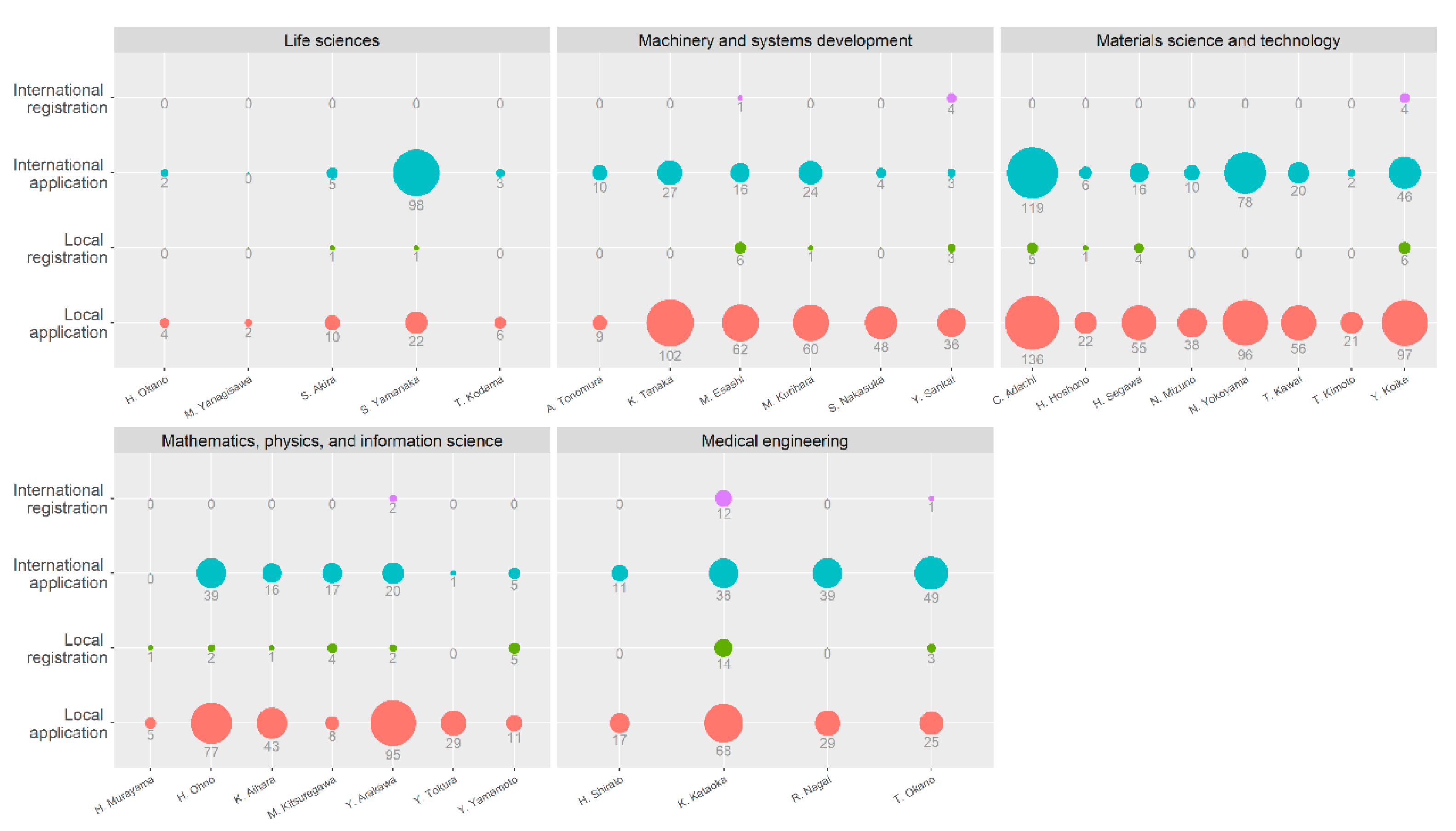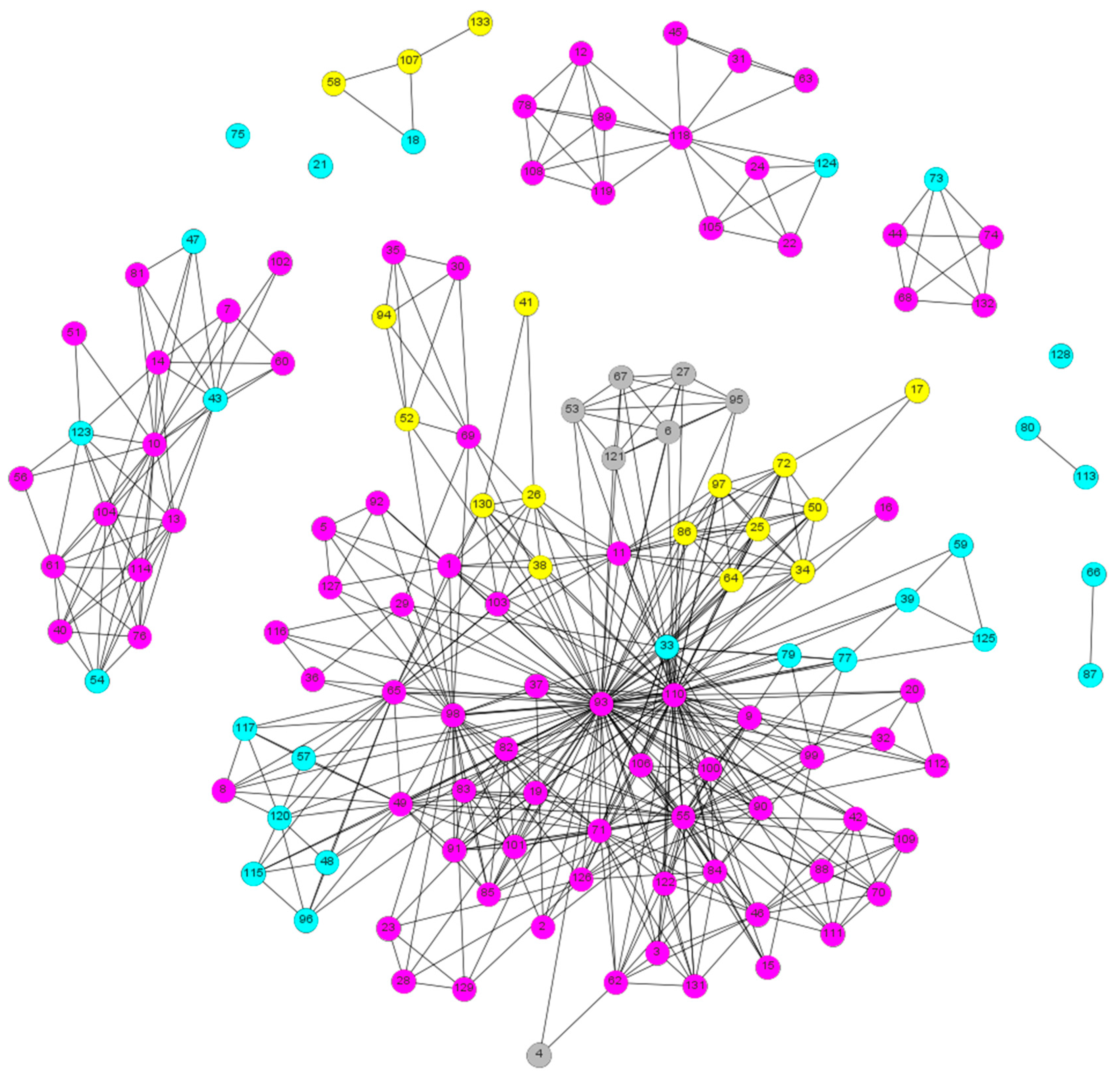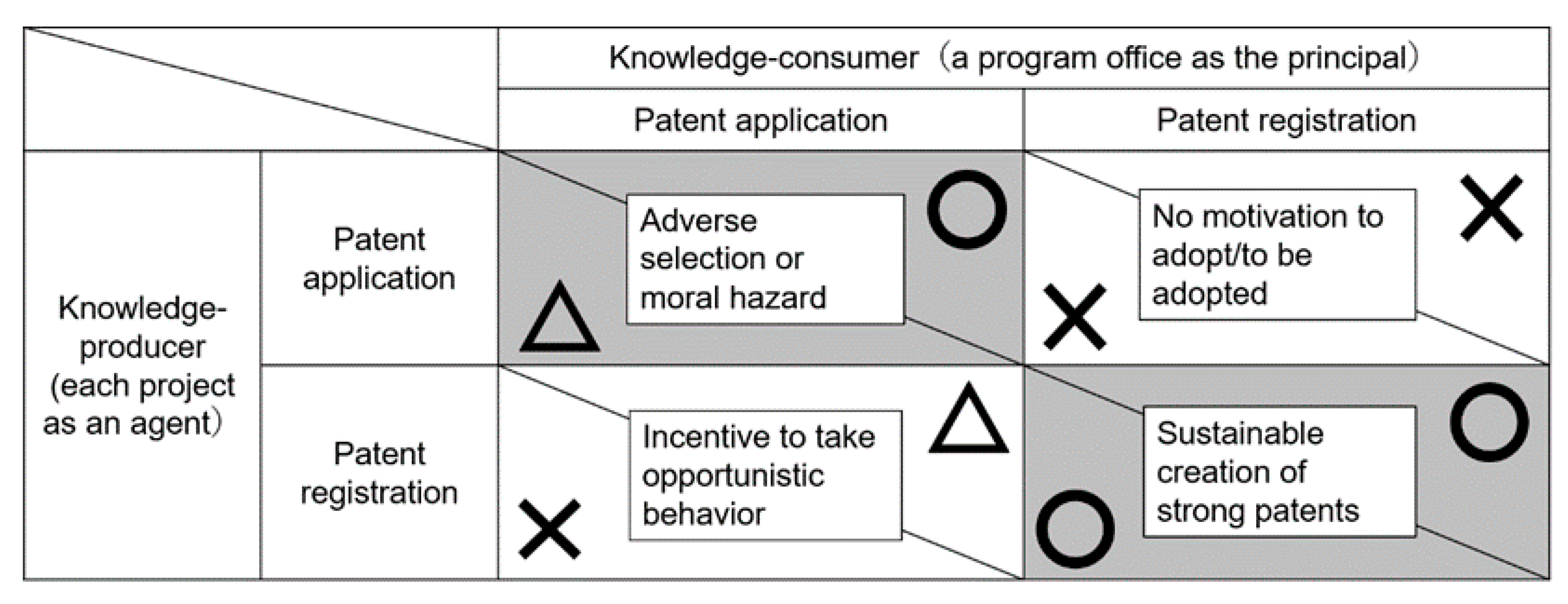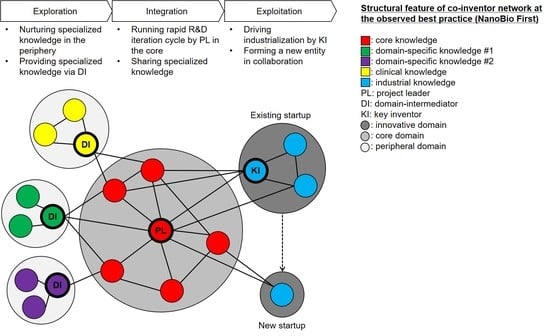Intellectual Property Management in Publicly Funded R&D Program and Projects: Optimizing Principal–Agent Relationship through Transdisciplinary Approach
Abstract
1. Introduction
2. Research Design
2.1. Theoretical Background
2.2. The Case
3. Materials and Methods
- Collection of patent data from NanoBio First
- Network analysis based on co-inventor networks
- Semistructured interviews with a project leader.
3.1. Collection of Patent Data
3.2. Quantitative Analysis: Network Analysis Based on Co-inventor Network
3.3. Qualitative Analysis: Semistructured Interview with Project Leader
- How could NanoBio First achieve the early creation and exploitation of intellectual property, such as patent registration and licensing?
- What was expected of collaborations between a university and a startup in NanoBio First?
- What kind of actor had the high centrality as extracted from the network analysis?
- Why was another startup established after NanoBio First when one already existed?
4. Results
4.1. Network Analysis Based on Co-Inventor Network
4.2. Qualitative Analysis of Intellectual Property Management
5. Discussion
5.1. Building a Knowledge Logistics System and the Contribution of a Startup
5.2. Information Asymmetry in Intellectual Property Management
5.2.1. Utilization of a Startup for Preventing Adverse Selection
5.2.2. Monitoring and Incentive Mechanisms for Avoiding Moral Hazard
5.3. Implications to the SDGs
5.4. Limitations and Future Perspectives
6. Conclusions
Author Contributions
Funding
Acknowledgments
Conflicts of Interest
References
- Grigss, D.; Stafford-Smith, M.; Gaffney, O.; Rockström, J.; Öhman, M.C.; Shyamsundar, P.; Steffen, W.; Glaser, G.; Kanie, N.; Noble, I. Sustainable development goals for people and planet. Nature 2013, 495, 305–307. [Google Scholar] [CrossRef] [PubMed]
- Voegtlin, C.; Scherer, A.G. Responsible Innovation and the Innovation of Responsibility: Governing Sustainable Development in a Globalized World. J. Bus. Ethics 2017, 143, 227–243. [Google Scholar] [CrossRef]
- Bogers, M.; Chesbrough, H.; Moedas, C. Open innovation: Research, practices, and policies. Calif. Manag. Rev. 2018, 60, 5–16. [Google Scholar] [CrossRef]
- Beck, S.; Bergenholtz, C.; Bogers, M.; Brasseur, T.M.; Conradsen, M.L.; Di Marco, D.; Distel, A.P.; Dobusch, L.; Dörler, D.; Effert, A.; et al. The Open Innovation in Science research field: A collaborative conceptualisation approach. Ind. Innov. 2020, 1–50. [Google Scholar] [CrossRef]
- Etzkowitz, H. The evolution of the entrepreneurial university. Int. J. Technol. Glob. 2004, 1, 64–77. [Google Scholar] [CrossRef]
- Wuchty, S.; Jones, B.F.; Uzzi, B. The increasing dominance of teams in production of knowledge. Science 2007, 316, 1036–1039. [Google Scholar] [CrossRef]
- Anzai, T.; Kusama, R.; Kodama, H.; Sengoku, S. Holistic observation and monitoring of the impact of interdisciplinary academic research projects: An empirical assessment in Japan. Technovation 2012, 32, 345–357. [Google Scholar] [CrossRef]
- Lauto, G.; Valentin, F. How Large-Scale Research Facilities Connect to Global Research. Rev. Policy Res. 2013, 30, 381–408. [Google Scholar] [CrossRef]
- Milojevic, S. Principles of scientific research team formation and evolution. Proc. Natl. Acad. Sci. USA 2014, 111, 3984–3989. [Google Scholar] [CrossRef]
- Lauto, G.; Sengoku, S. Perceived incentives to transdisciplinarity in a Japanese university research center. Futures 2015, 65, 136–149. [Google Scholar] [CrossRef]
- Katoh, S.; Lauto, G.; Anzai, T.; Sengoku, S. Identification of factors to promote interdisciplinary research: A trial at COINS. In Proceedings of the 2018 Portland International Conference on Management of Engineering and Technology (PICMET), Honolulu, HI, USA, 19–23 August 2018; pp. 1–11. [Google Scholar]
- Sauermann, H.; Vohland, K.; Antoniou, V.; Balázs, B.; Göbel, C.; Karatzas, K.; Mooney, P.; Perelló, J.; Ponti, M.; Samson, R.; et al. Citizen science and sustainability transitions. Res. Policy 2020, 49, 103978. [Google Scholar] [CrossRef]
- D’Este, P.; Patel, P. University-industry linkages in the UK: What are the factors underlying the variety of interactions with industry? Res. Policy 2007, 36, 1295–1313. [Google Scholar] [CrossRef]
- Perkmann, M.; Tartari, V.; McKelvey, M.; Autio, E.; Broström, A.; D’Este, P.; Fini, R.; Geuna, A.; Grimaldi, R.; Hughes, A.; et al. Academic engagement and commercialization: A review of the literature on university-industry relations. Res. Policy 2013, 42, 423–442. [Google Scholar] [CrossRef]
- Gans, J.S.; Murray, F.E.; Stern, S. Contracting over the disclosure of scientific knowledge: Intellectual property and academic publication. Res. Policy 2017, 46, 820–835. [Google Scholar] [CrossRef]
- Siegel, D.S.; Veugelers, R.; Wright, M. Technology transfer offices and commercialization of university intellectual property: Performance and policy implications. Oxf. Rev. Econ. Policy 2007, 23, 640–660. [Google Scholar] [CrossRef]
- Bannerman, S. The World Intellectual Property Organization and the sustainable development agenda. Futures 2020, 122, 102586. [Google Scholar] [CrossRef]
- Alos-Simo, L.; Verdu-Jover, A.J.; Gomez-Gras, J.M. Knowledge transfer in sustainable contexts: A comparative analysis of periods of financial recession and expansion. Sustainability 2020, 12, 4916. [Google Scholar] [CrossRef]
- Bozeman, B. Technology transfer and public policy: A review of research and theory. Res. Policy 2000, 29, 627–655. [Google Scholar] [CrossRef]
- Battistella, C.; De Toni, A.F.; Pillon, R. Inter-organisational technology/knowledge transfer: A framework from critical literature review. J. Technol. Transf. 2016, 41, 1195–1234. [Google Scholar] [CrossRef]
- Wijnhoven, F. Knowledge logistics in business contexts: Analyzing and diagnosing knowledge sharing by logistics concepts. Knowl. Process. Manag. 1998, 5, 143–157. [Google Scholar] [CrossRef]
- Wijnhoven, F. Operational knowledge management: Identification of knowledge objects, operation methods, and goals and means for the support function. J. Oper. Res. Soc. 2003, 54, 194–203. [Google Scholar] [CrossRef]
- Jick, T.D. Mixing Qualitative and Quantitative Methods: Triangulation in Action. Adm. Sci. Q. 1979, 24, 602–611. [Google Scholar] [CrossRef]
- Eisenhardt, K.M. Building Theories from Case Study Research. Acad. Manag. Rev. 1989, 14, 532–550. [Google Scholar] [CrossRef]
- United Nations. Transforming our world: The 2030 agenda for sustainable development. In Resolution Adopted by the General Assembly on 25 September 2015; RES/70/1; UN: New York, NY, USA, 2015. [Google Scholar]
- United Nations. Work of the Statistical Commission pertaining to the 2030 Agenda for Sustainable Development. In Resolution Adopted by the General Assembly on 6 July 2017; A/RES/71/313; UN: New York, NY, USA, 2017. [Google Scholar]
- Millennium Ecosystem Assessment. Ecosystems and Human Well-Being: Biodiversity Synthesis; World Resources Institute: Washington, DC, USA, 2005. [Google Scholar]
- Zscheischler, J.; Rogga, S.; Busse, M. The adoption and implementation of transdisciplinary research in the field of land-use science—A comparative case study. Sustainability 2017, 9, 1926. [Google Scholar] [CrossRef]
- Kajikawa, Y.; Tacoa, F.; Yamaguchi, K. Sustainability science: The changing landscape of sustainability research. Sustain. Sci. 2014, 9, 431–438. [Google Scholar] [CrossRef]
- Chesbrough, H. Open Innovation: The New Imperative for Creating and Profiting from Technology; Harvard Business School Press: Boston, MA, USA, 2003. [Google Scholar]
- Chesbrough, H. Open Services Innovation: Business Rethinking your Business to Grow and Compete in a New Era; Jossey Bass: San Francisco, CA, USA, 2011. [Google Scholar]
- Yun, J.H.J.; Jeong, E.S.; Park, J.S. Network analysis of open innovation. Sustainability 2016, 8, 729. [Google Scholar] [CrossRef]
- Huggins, R.; Prokop, D.; Thompson, P. Universities and open innovation: The determinants of network centrality. J. Technol. Transf. 2020, 45, 718–757. [Google Scholar] [CrossRef]
- Repko, A.F. Interdisciplinary Research: Process and Theory, 2nd ed.; Sage: Thousand Oaks, CA, USA, 2012. [Google Scholar]
- König, B.; Diehl, K.; Tscherning, K.; Helming, K. A framework for structuring interdisciplinary research management. Res. Policy 2013, 42, 261–272. [Google Scholar] [CrossRef]
- Klein, J.T. Unity of knowledge and transdisciplinarity: Contexts of definition, theory and the new discourse of problem solving. In Unity of Knowledge (in Transdisciplinary Research for Sustainability). Encyclopedia of life support systems. 2003. Available online: www.eolss.net (accessed on 11 November 2020).
- Stock, P.; Burton, R.J. Defining terms for integrated (multi-inter-trans-disciplinary) sustainability research. Sustainability 2011, 3, 1090–1113. [Google Scholar] [CrossRef]
- Adler, C.; Hirsch Hadorn, G.; Breu, T.; Wiesmann, U.; Pohl, C. Conceptualizing the transfer of knowledge across cases in transdisciplinary research. Sustain. Sci. 2018, 13, 179–190. [Google Scholar] [CrossRef]
- Brandt, P.; Ernst, A.; Gralla, F.; Luederitz, C.; Lang, D.J.; Newig, J.; Reinert, F.; Abson, D.J.; Von Wehrden, H. A review of transdisciplinary research in sustainability science. Ecol. Econ. 2013, 92, 1–15. [Google Scholar] [CrossRef]
- Klein, J.T. Evaluation of Interdisciplinary and Transdisciplinary Research. A Literature Review. Am. J. Prev. Med. 2008, 35, 116–123. [Google Scholar] [CrossRef] [PubMed]
- Eisenhardt, K.M. Agency Theory: An Assessment and Review. Acad. Manag. Rev. 1989, 14, 57–74. [Google Scholar] [CrossRef]
- Jensen, M.C.; Meckling, W.H. Theory of the Firm: Managerial Behavior, Agency Costs and Ownership Structure. J. Financ. Econ. 1976, 3, 305–360. [Google Scholar] [CrossRef]
- Holmstrom, B. Moral Hazard and Observability. Bell J. Econ. 1979, 10, 74. [Google Scholar] [CrossRef]
- Bergh, D.D.; Ketchen, D.J.; Orlandi, I.; Heugens, P.P.; Boyd, B.K. Information Asymmetry in Management Research: Past Accomplishments and Future Opportunities. J. Manag. 2019, 45, 122–158. [Google Scholar] [CrossRef]
- Akerlof, G.A. The Market for “Lemons”: Quality Uncertainty and the Market Mechanism. Q. J. Econ. 1970, 84, 488–500. [Google Scholar] [CrossRef]
- Bergmann, R.; Friedl, G. Controlling innovative projects with moral hazard and asymmetric information. Res. Policy 2008, 37, 1504–1514. [Google Scholar] [CrossRef]
- Sappington, D.E.M. Incentives in Principal-Agent Relationships. J. Econ. Perspect. 1991, 5, 45–66. [Google Scholar] [CrossRef]
- Ollier, S.; Thomas, L. Ex post participation constraint in a principal-agent model with adverse selection and moral hazard. J. Econ. Theory 2013, 148, 2383–2403. [Google Scholar] [CrossRef]
- Riley, J.G. Silver signals: Twenty-five years of screening and signaling. J. Econ. Lit. 2001, 39, 432–478. [Google Scholar] [CrossRef]
- Delfgaauw, J.; Dur, R. Signaling and screening of workers’ motivation. J. Econ. Behav. Organ. 2007, 62, 605–624. [Google Scholar] [CrossRef]
- Connelly, B.L.; Certo, S.T.; Ireland, R.D.; Reutzel, C.R. Signaling theory: A review and assessment. J. Manag. 2011, 37, 39–67. [Google Scholar] [CrossRef]
- Arnott, B.R.; Stiglitz, J.E. Moral Hazard and Nonmarket Institutions: Dysfunctional Crowding Out of Peer Monitoring. Am. Econ. Rev. 1991, 81, 179–190. [Google Scholar]
- Levin, J. American Economic Association Relational Incentive Contracts. Am. Econ. Rev. 2003, 93, 835–857. [Google Scholar] [CrossRef]
- Lewis, G.; Bajari, P. Moral hazard, incentive contracts, and risk: Evidence from procurement. Rev. Econ. Stud. 2014, 81, 1201–1228. [Google Scholar] [CrossRef]
- Funding Program for World-Leading Innovative R&D on Science and Technology (FIRST Program). Available online: https://www.jsps.go.jp/english/e-first/index.html. (accessed on 18 October 2020).
- NanoBio FITST—Funding Program for World-Leading Innovative R&D on Science and Technology—Development of Innovative Diagnostic and Therapeutic Systems Based on nanobiotechnology. Available online: http://park.itc.u-tokyo.ac.jp/nanobiof/en/index.html (accessed on 18 October 2020).
- Interim evaluation of Funding Program for World-Leading Innovative R&D on Science and Technology. Available online: https://www8.cao.go.jp/cstp/sentan/sentan_chukan.html (accessed on 18 October 2020).
- Ex post evaluation of Funding Program for World-Leading Innovative R&D on Science and Technology. Available online: https://www8.cao.go.jp/cstp/sentan/sentan_jigo.html (accessed on 18 October 2020).
- Follow-up evaluation of Funding Program for World-Leading Innovative R&D on Science and Technology. Available online: https://www8.cao.go.jp/cstp/sentan/sentan_tuiseki.html (accessed on 18 October 2020).
- Harrison, R.L.; Reilly, T.M.; Creswell, J.W. Methodological Rigor in Mixed Methods: An Application in Management Studies. J. Mixed Methods Res. 2020, 14, 473–495. [Google Scholar] [CrossRef]
- Klassen, A.C.; Creswell, J.; Plano Clark, V.L.; Smith, K.C.; Meissner, H.I. Best practices in mixed methods for quality of life research. Qual. Life Res. 2012, 21, 377–380. [Google Scholar] [CrossRef]
- Takano, Y.; Mejia, C.; Kajikawa, Y. Unconnected component inclusion technique for patent network analysis: Case study of Internet of Things-related technologies. J. Informetr. 2016, 10, 967–980. [Google Scholar] [CrossRef]
- Japan Platform for Patent Information (J-PlatPat). Available online: https://www.j-platpat.inpit.go.jp (accessed on 18 October 2020).
- Espacenet. Available online: https://worldwide.espacenet.com (accessed on 18 October 2020).
- Narin, F. Patent bibliometrics. Scientometrics 1994, 30, 147–155. [Google Scholar] [CrossRef]
- Ernst, H. Patent information for strategic technology management. World Pat. Inf. 2003, 25, 233–242. [Google Scholar] [CrossRef]
- Kim, K.; Jung, S.; Hwang, J. Technology convergence capability and firm innovation in the manufacturing sector: An approach based on patent network analysis. R D Manag. 2019, 49, 595–606. [Google Scholar] [CrossRef]
- Érdi, P.; Makovi, K.; Somogyvári, Z.; Strandburg, K.; Tobochnik, J.; Volf, P.; Zalányi, L. Prediction of emerging technologies based on analysis of the US patent citation network. Scientometrics 2013, 95, 225–242. [Google Scholar] [CrossRef]
- Albert, M.B.; Avery, D.; Narin, F.; McAllister, P. Direct validation of citation counts as indicators of industrially important patents. Res. Policy 1991, 20, 251–259. [Google Scholar] [CrossRef]
- Rodríguez-Salvador, M.; Rio-Belver, R.M.; Garechana-Anacabe, G. Scientometric and patentometric analyses to determine the knowledge landscape in innovative technologies: The case of 3D bioprinting. PLoS ONE 2017, 12, e0180375. [Google Scholar] [CrossRef]
- Borgatti, S.P.; Everett, M.G. Models of core /periphery structures. Soc. Netw. 1999, 21, 375–395. [Google Scholar] [CrossRef]
- Fonti, F.; Maoret, M. The direct and indirect effects of core and peripheral social capital on organizational performance. Strateg. Manag. J. 2016, 37, 1765–1786. [Google Scholar] [CrossRef]
- Baldwin, C.Y. Where do transactions come from? Modularity, transactions, and the boundaries of firms. Ind. Corp. Chang. 2008, 17, 155–195. [Google Scholar] [CrossRef]
- Godin, B. The linear model of innovation: The historical construction of an analytical framework. Sci. Technol. Hum. Values 2006, 31, 639–667. [Google Scholar] [CrossRef]
- Mincer, J. On-the-Job Training: Costs, Returns, and Some Implications. J. Political Econ. 1962, 57270, 50–79. [Google Scholar] [CrossRef]
- Nakajima, Y.; Miyashita, S.; Sengoku, S. Innovative Advanced Technology through University-Industry Collaboration: Role of Venture Capitals, Entrepreneurs and Process Management in Japan. Asian J. Innov. Policy 2018, 7, 564–580. [Google Scholar]



| Researcher’s Affiliation | Number of Affiliations | Number of Created Intellectual Property | Subtotal Number of Inventors |
|---|---|---|---|
| University | 6 | 41 (15) | 83 |
| Industry | 10 | 46 (19) | 26 |
| Public | 5 | 12 (3) | 17 |
| Other | - | - | 7 |
| Inventor | Sector | Degree Centrality |
|---|---|---|
| Inventor 93 | University | 80 |
| Inventor 110 | University | 59 |
| Inventor 55 | University | 37 |
| Inventor 98 | University | 27 |
| Inventor 33 | Industry | 25 |
| Inventor 71 | University | 20 |
| Inventor 49 | University | 19 |
| Inventor 10 | University | 17 |
| Inventor 11 | University | 16 |
| Inventor 65 | University | 16 |
| Inventor 84 | University | 16 |
| Inventor 46 | University | 14 |
| Inventor 1 | University | 12 |
| Inventor 118 | University | 12 |
| Inventor 122 | University | 12 |
| Inventor 126 | University | 12 |
| Inventor 19 | University | 11 |
| Inventor 50 | Public | 11 |
| Inventor 72 | Public | 11 |
| Inventor 82 | University | 11 |
| Inventor 83 | University | 11 |
| Inventor 85 | University | 11 |
| Inventor 91 | University | 11 |
| Inventor 100 | University | 11 |
| Inventor 101 | University | 11 |
| Inventor | Sector | Betweenness Centrality |
|---|---|---|
| Inventor 93 | University | 2025.55 |
| Inventor 110 | University | 629.10 |
| Inventor 55 | University | 140.94 |
| Inventor 98 | University | 139.83 |
| Inventor 69 | University | 135.97 |
| Inventor 52 | Public | 107.70 |
| Inventor 33 | Industry | 88.94 |
| Inventor 10 | University | 57.25 |
| Inventor 118 | University | 47.00 |
| Inventor 26 | Public | 41.50 |
| Inventor 50 | Public | 41.50 |
| Inventor 72 | Public | 41.50 |
| Inventor 130 | Public | 41.50 |
| Inventor 49 | University | 39.00 |
| Inventor 65 | University | 31.33 |
| Inventor 11 | University | 20.92 |
| Inventor 71 | University | 19.41 |
| Inventor 1 | University | 13.67 |
| Inventor 84 | University | 10.21 |
| Inventor 43 | Industry | 10.20 |
| Inventor 126 | University | 9.73 |
| Inventor 46 | University | 7.50 |
| Inventor 14 | University | 6.20 |
| Inventor 123 | Industry | 4.95 |
| Inventor 62 | University | 4.00 |
| Question | Observed Fact | Implication |
|---|---|---|
| Q 1: How could NanoBio First achieve early creation and exploitation of intellectual property, such as patent registration and licensing? |
|
|
| Q 2: What was expected of collaborations between a university and a startup in NanoBio First? |
|
|
| Q 3: What kind of actor had the high centrality (i.e., Inventor 33 in Figure 2) as extracted from the network analysis? |
|
|
| Q 4: Why was another startup (i.e., AccuRna) established after NanoBio First when one already existed? |
|
|
Publisher’s Note: MDPI stays neutral with regard to jurisdictional claims in published maps and institutional affiliations. |
© 2020 by the authors. Licensee MDPI, Basel, Switzerland. This article is an open access article distributed under the terms and conditions of the Creative Commons Attribution (CC BY) license (http://creativecommons.org/licenses/by/4.0/).
Share and Cite
Miyashita, S.; Katoh, S.; Anzai, T.; Sengoku, S. Intellectual Property Management in Publicly Funded R&D Program and Projects: Optimizing Principal–Agent Relationship through Transdisciplinary Approach. Sustainability 2020, 12, 9923. https://doi.org/10.3390/su12239923
Miyashita S, Katoh S, Anzai T, Sengoku S. Intellectual Property Management in Publicly Funded R&D Program and Projects: Optimizing Principal–Agent Relationship through Transdisciplinary Approach. Sustainability. 2020; 12(23):9923. https://doi.org/10.3390/su12239923
Chicago/Turabian StyleMiyashita, Shuto, Shogo Katoh, Tomohiro Anzai, and Shintaro Sengoku. 2020. "Intellectual Property Management in Publicly Funded R&D Program and Projects: Optimizing Principal–Agent Relationship through Transdisciplinary Approach" Sustainability 12, no. 23: 9923. https://doi.org/10.3390/su12239923
APA StyleMiyashita, S., Katoh, S., Anzai, T., & Sengoku, S. (2020). Intellectual Property Management in Publicly Funded R&D Program and Projects: Optimizing Principal–Agent Relationship through Transdisciplinary Approach. Sustainability, 12(23), 9923. https://doi.org/10.3390/su12239923







